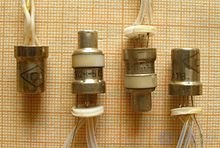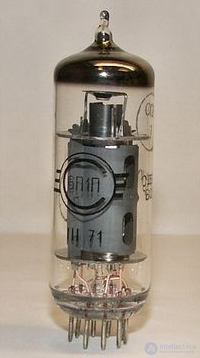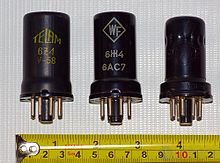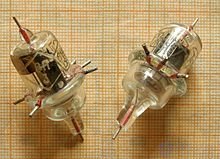Lecture
Radio tubes (vacuum tubes) produced in the USSR and now produced in Russia.
An electronic vacuum tube, radio tube, is an electrovacuum device (more precisely, a vacuum electronic device) that operates by controlling the intensity of the flow of electrons moving in a vacuum or rarefied gas between electrodes.
Radio tubes were widely used in the 20th century as the main elements of radio equipment, since they allow current to be rectified, amplify, generate electrical signals, etc. With the advent of semiconductor devices (diodes, transistors), radio tubes began to be displaced from radio equipment, since semiconductor devices turned out to be much more compact and economical. Currently, radio tubes are found where semiconductor analogs are more expensive or more difficult to manufacture, for example, a radio tube - a magnetron - is used as a powerful generator of radio waves in a microwave oven. Tubes are traditionally used in some types of audio equipment positioned as high-end, and tubes are also installed in the output stages of radar transmitters or powerful communications equipment.
Vacuum tubes intended for lighting (flash lamps, xenon lamps, mercury and sodium lamps) are not called tubes and usually belong to the class of lighting devices.
Vacuum tubes intended for converting electrical signals into optical information (transmitting television tubes, oscilloscopes, memory tubes, kinescopes, cathode-ray switches (trochotrons, dekatrons), indicator CRTs) belong to the class of cathode-ray devices.
Cathode-ray devices are based on the same principles as tubes, but, in addition to controlling the intensity of the electron flow, they also control the distribution of electrons in space and therefore are allocated to a separate group. Also, microwave vacuum tubes are classified into a separate group, based on the interaction of an electron flow with an electromagnetic field in devices such as a magnetron, klystron, etc.
The first and - subsequently - the largest factories in Russia are the Leningrad association Svetlana, which later produced many other details besides lamps, and the Moscow Electric Lamp Plant (MELZ). Both enterprises were founded before the Great October Socialist Revolution, and for all the time of their existence, radio tubes were and remain their main products. At Svetlana (this plant was twice awarded the Order of Lenin for its work and twice with the Order of the Red Banner of Labor, such a “kit” says a lot) a huge range of receiving-amplifying and special radio tubes is produced. Possessing a huge scientific and production potential and a well-equipped material and technical base, the Svetlana production team developed and introduced into production a lot of radio tubes of a completely new purpose and design, some of them have no analogues and were not produced by other factories. ). Despite the fact that the main products of MELZ were kinescopes, the plant also produced radio tubes, in particular, the double triodes 6Н8С and 6Н9С, which to this day are especially appreciated by amateur radio designers of high-quality sound reproduction equipment. Radiolamps also produces the Saratov receiver-amplifying lamp plant.
The names of the first Soviet radio tubes were chosen arbitrarily: PR-1 (“first hollow relay”, 1918), R-5 (“fifth relay”, 1922), “Micro” (1923, the name indicated a lower power consumption of the lamp). ), "Micro DS" ("two-grid", 1927) .
Since 1929, the first unified notation was introduced, in which the first letter denoted the type of lamp, the second (optional) the type of cathode, and the number the development number. Thus, the CO-242 index meant: special (in this case, the heptod), with an oxide cathode, design No. 242. The designations were not very informative, since most of the new lamps fell into the category of “special”. In fact, they were used until the early 1950s, while the corresponding lamps were produced and used, although by that time new indexes were introduced (for example, the SO-257 pentode was also called 2Zh4).
With the deployment in 1937 of the production of a number of octal lamps under a license from the United States, a special notation was adopted for them. In it, the first element is a digit indicating the filament voltage in volts, the second is a letter indicating the type of lamp, and the third is a digit is the number of electrodes placed on the pins of the base. Thus, the licensed triode with 6-volt filament was designated 6F5, and the pentode - 6F6. Such a system was also far from perfect, and in 1940 a new one was proposed, close to the modern one (see below). Due to the outbreak of war, its implementation was delayed. When, under Lend-Lease, American equipment and lamps began to arrive in the country, in order to avoid confusion, their Soviet-made counterparts were marked by the American system, sometimes replacing Latin letters with Cyrillic letters (for example, 6AJ5 and 6АЖ5 - the same lamp). At the same time, lamps with markings of 1929 and 1940 were produced.
The modern system of designation of radio tubes introduced in the early 1950s. (GOST 5461-50) and since then has been clarified several times. According to it the designation of the lamp consists of five elements (the fifth element is optional). It should be noted that for some lamps of old editions, the old names are kept.
Element 1 - the number denoting the rounded value of the filament voltage (for receiving-amplifying lamps):
| Number | Filament voltage |
|---|---|
| 06 | 625 mV |
| one | 800 mV, 1 V, 1.2 V, 1.4 V, 1.5 V |
| 2 | 2 V, 2.2 V, 2.4 V |
| 3 | 3.15 V |
| four | 4 V, 4.2 V, 4.4 V |
| five | 5 V |
| 6 | 6 V, 6.3 V |
| 7 | 7 V |
| 9 | 9 V |
| ten | 10V |
| 12 | 12 V, 12.6 V |
| 13 | 13 V |
| 17 | 17 V |
| 18 | 18 V |
| 20 | 20 V |
| 25 | 25.2 V |
| thirty | 30 V |
For generator lamps, barretters and zener diodes - the letter index indicating the type of lamp:
| Gi | Pulse generator lamp |
| GM | Modulator lamp |
| GMI | Pulse modulator lamp |
| R | Generator lamp (for old edition lamps) |
| GK | Generator HF lamp (for frequencies up to 25 MHz) |
| GU (for example, GU-50 | VHF generator lamp (for frequencies up to 0.6 GHz) |
| HS | Microwave generator lamp (for frequencies above 0.6 GHz) |
| GP | Control lamp |
| GPI | Control flash lamp |
| SG | Gas-filled voltage regulator (Zener diode) |
| ST | Gas Filled Current Stabilizer (Baretter) |
In kinescopes and oscillographic tubes, a number indicating the diameter or diagonal of the screen in centimeters.
Element 2 - the letter (or two letters) of the Russian alphabet, denoting the type of electrode system of the lamp (for receiving-amplifying lamps):
| Letter | Type of electrode system |
|---|---|
| BUT | Frequency conversion lamps (hexode, heptod) |
| B | Diode-pentode, double diode-pentode (combined lamp) |
| AT | Secondary emission lamp |
| R | Diode-triode, dual diode-triode, triple diode-triode (combination lamp) |
| D | Single diode (except rectifier kenotron) |
| E | Electronic light indicator |
| F | High Frequency Pentode |
| AND | Triode-heptode or triode-hexode (combined lamp) |
| TO | High-frequency pentode with extended characteristic (“varimu”) |
| L | Beam lamp (except ray tetrode) |
| H | Double triode |
| P | Output pentode or beam tetrode |
| R | Double tetrode, double beam tetrode or double pentode |
| WITH | Triode |
| F | Triode-pentode (combined lamp), with the exception of the old-type pentode 6F6S |
| X | Dual diode (except kenotrons) |
| C | Rectifying diode (kenotron) of any type |
| Uh | Tetrod |
| CP | Double pentode-triode |
Octodes do not have designations, since these lamps were not produced in the USSR and are not produced now in Russia.
At kinescopes and oscillographic tubes:
| LO | Oscillographic tube or kinescope with electrostatic beam deflection |
| LC | Kinescope with electromagnetic beam deflection |
| LM | Oscillographic tube with electromagnetic beam deflection |
The Zener diodes and boretters have a number designating the development number. The generator lamps of the second element have no designation.
Element 3: For generator and receiver-amplifying lamps, kinescopes and oscillograph tubes - a number indicating the development number. At the zener diodes and barretters - the same as the 4th element for receiving-amplifying lamps.
Element 4: For zener diodes and barretters absent. In kinescopes and oscillographic tubes, may indicate the type of phosphor used for the screen ( see Kinescope # Designation and Marking ). In receiving-amplifying lamps - the letter designating the lamp design:
| Letter | Design |
|---|---|
| BUT | Subminiature glass balloon with a diameter of 5-8 mm with flexible wire leads |
| B | Subminiature glass balloon with a diameter of 8-10.2 mm with flexible wire leads |
| R | Miniature glass bottle with a diameter of more than 10.2 mm with flexible wire leads |
| D | Ceramic cylinder with disk outputs ("beacon" lamp) |
| F | An acorn lamp is a miniature glass bottle with rigid radial leads. |
| TO | Ceramic cylinder with pins. |
| L | Lamp with octal base, equipped with a lock, which excludes falling out of the lamp from the panel when shaking ("elbow"). The cylinder is glass, outside closed by an aluminum casing. |
| M | Compact glass bottle with a reduced height octal base (“Malgab”). The letter is preserved only for some lamps of old editions (2K2M, 2Zh2M, 2P9M, 30TS1M, etc.). |
| H | Nuvistor (miniature lamp in a cermet balloon). |
| P | The miniature (“finger”) lamp is a glass balloon with a diameter of up to 22 mm with seven (“heptal”) or nine (“nostalgia”) rigid leads soldered directly to the bottom. |
| WITH | Oversized glass with a diameter of more than 22.5 mm or a cermet container, including an octal base. |
| R | Subminiature glass balloon with a diameter of less than 5 mm with flexible wire leads. In this design was released a single lamp - 1ZH25R) |
| No letter | Metal (usually steel) cylinder with octal cap |
The generator lamps - the letter indicates the type of cooling:
| Letter | Cooling |
|---|---|
| BUT | Forced liquid, water or air-water |
| B | Forced air |
| TO | Contact |
| P | Evaporative |
| No letter | Natural air |
Other devices have a fourth element missing.
Element 5 - characterizes the special properties of lamps. Optional, always placed with a hyphen, applicable only to receiving and amplifying lamps.
| Letter | Value |
|---|---|
| AT | Lamp of high mechanical strength and reliability |
| E | High durability lamp (5000 hours or more) |
| D | Highly durable lamp (10,000 hours or more) |
| AND | A lamp designed to operate in a pulsed mode |
| TO | Lamp of increased mechanical strength and reliability with high vibration resistance |
| R | A lamp of increased mechanical strength and reliability, with increased radiation resistance (better than B; however, to replace a lamp of group B, both P and B must be present in the designation) |
In the fifth element, the designation can use several letters at once, for example, 6П14П-ЕВ - the output pentode of increased mechanical strength, reliability and increased durability. It should be noted that not all lamp designations correspond to the system (but this is extremely rare), for example, for the GU-72 lamp, the maximum operating frequency is 10 MHz, and the GK-71, whose rated operating frequency is 20 MHz, can operate at frequencies up to 60 MHz (and such lamps are usually referred to as PG). Also, some receiving-amplifying lamps, marked as output (6П24Б, 4П1Л, 6П3С, 6П6С, 6П7С, 6П13С, 6П20С, 6П21С, 6П31С, 6П36С, 6П41С, 6П42С, 6П44С, 6П45С, etc.), can work as generator ones.
6D3D - high frequency diode
6D4ZH, 6D6A - diodes designed to detect signals
6D20P - Damping Diode, used in black and white TVs with a beam deflection angle of 110 degrees
6H2P, 6H6S, 6H7B, 12H3S - dual diodes used to detect signals
1Ts1S, 1Ts7S, 1Ts11P, 1Ts21P - high-voltage Kenotrons, used in the nodes of the horizontal scanning TVs
2Ц2С - high voltage Kenotron
5Ц3С, 5Ц4М, 5Ц4С, 5Ц8С, 5Ц9С, 5Ц12П, 6Ц4П, 6Ц5С, 6Ц10П, 30Ц1М, 30Ц6С - kenotrons used in power supply units for lamp radio equipment
| Type of | Purpose |
|---|---|
| For cascades of low-frequency voltage amplification in reproducing equipment | |
| 6С2С, 6С3С, 6С5С | Single high gain triodes |
| 6Н1П, 6Н8С | Medium Gain Double Triodes |
| 6N2P, 6N9S | High Gain Dual Triodes |
| For preliminary cascades of low-frequency power amplification in reproducing equipment | |
| 6N6P, 6N30P | Dual triodes with low internal resistance |
| For terminal stages of low-frequency power amplification in reproducing equipment | |
| 6С4С (2С4С) | Single output triode |
| 6Н5С | Double triode with low internal resistance |
| Regulator lamps for voltage regulators | |
| 6S19P | Single triode with low internal resistance |
| 6С33С (6С18С) | Powerful glass triode with low internal resistance and high toughness. |
| 6Н13С (6Н5С) | Double triode with low internal resistance |
| For preliminary cascades of high-frequency voltage gain (low power high-frequency) | |
| 6S3P (6S4P) | High Frequency Triode with Medium Gain. Durability of at least 500 hours |
| 6С4П | High-frequency triode to amplify high-frequency voltage mainly in circuits with a grounded grid. Durability of at least 500 hours |
| 6S15P (6S45P) | Single triode with high toughness |
| 6C16B (6S17B) | |
| 6C51H | |
| 6N3P (6N5P) | Double triode for operation as a transducer and a local oscillator in VHF blocks of lamp radios |
| 6N23P | Dual universal triode for operation as a broadband amplifier and high-frequency mixer with low noise and in the circuits of low-power amplifiers and generators. Durability of at least 1000 hours |
Low frequency output
6S4S, GM-70
For voltage regulators
6S19P | 6C33C (6C18C) | GP-5
6E5P, 6E6P, 6E12P - HF tetrodes 6P3S, EL34
6P13S, 6P36S, 6P45S - ray tetrodes for horizontal scanning blocks of TVs.
6P14P - LF output pentode
GU-50 - RF output pentode
6A7, 6A2P, 6A10P - heptode converters for radio receivers. 6I1P, 6I4P - triode-heptodes. 6L7 - beam mixing lamp.

Soviet-made Nuvistors

Subminiature core pentode 1P24B

Finger tetrode 6P1P

"Metal" pentode 6ZH4 (American designation - 6AC7). From left to right - made in Poland, GDR, USSR

Generator lamps - doubletrodes GU-19, GU-32, GU-29, GI-30

Pentodes 6Ж1Ж type "acorn"
Ceramic-metal generating triode GS-9B with air cooling (USSR)
Comments
To leave a comment
Radio tubes and ion devices
Terms: Radio tubes and ion devices